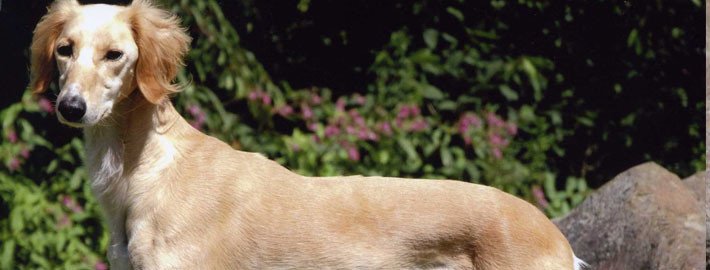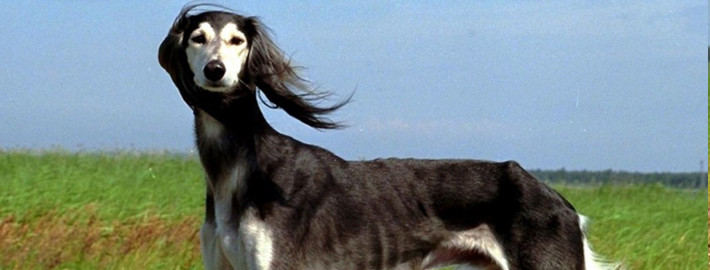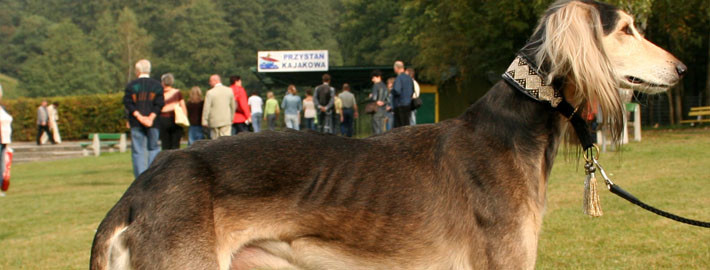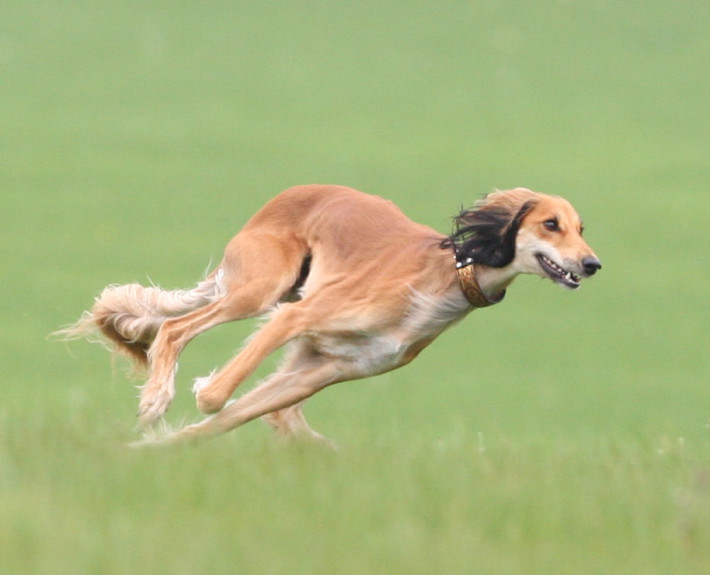What makes the Saluki (or Gazelle Hound) Unique?
The Saluki has a general greyhound-like build and should combine grace, symmetry, great speed and endurance. Likwise, it should have the strength to enable it to kill gazelle or other quarry over deep sand or rocky mountains. Its expression should be dignified and gentle, with deep, faithful, far-seeing eyes. Its movement is light. The coat is smooth and silky; the feathered variety has long hair on its ears, tail, between its toes and sometimes on the backs of its legs; the smooth variety has no long feathering. This breed has a wide range of equally acceptable types, reflecting the wide area over which it was developed. The Saluki tends to be aloof and reserved with strangers. It is extremely devoted to its own family, but it is not particularly demonstrative. The Saluki is very gentle with children, but it may not be playful enough to satisfy most of them. Extremely sensitive, it does not take to rough-and-tumble play or deal well with harsh corrections. Some Salukis can be shy. This breed is very quiet and sedate indoors, seeking out a soft, warm spot. Outside, it runs in great circles at tremendous speeds and will chase any small running animals or fast-moving objects. It may not come when called.
Breed Groups
- Hound Dog Breeds
- Medium Size
Page Contents
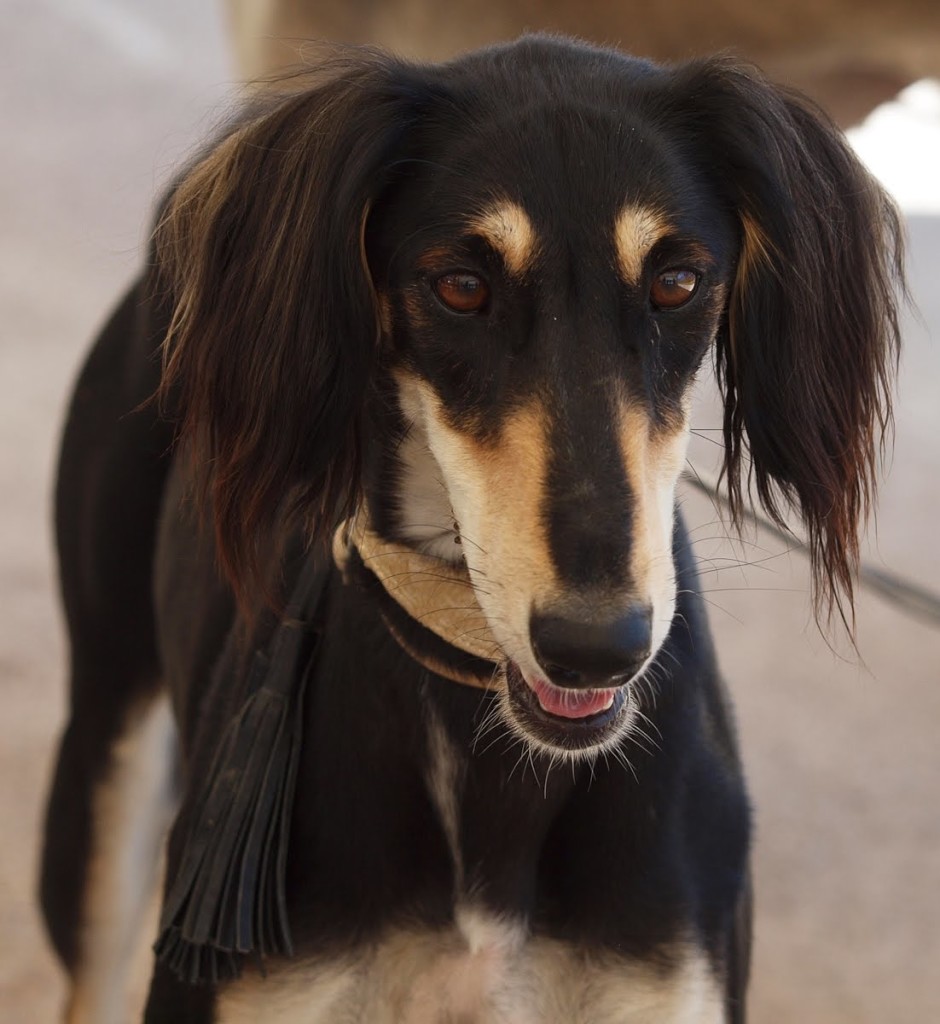
SnapShot
| Size: | Males – 23-28 inches (58-71 cm) Females – 18-26 inches (45.7-66 cm) |
| Weight: | Males – 45-65 pounds (20.5-29.5 kg) Females – 35-55 pounds (15.9-25 kg) |
| Origin: | Middle East |
| Life Span: | 12 to 14 years |
| Colour: | White, cream, fawn, golden, red, grizzle and tan tricolor (black, tan and white), black and tan, or any of the previously mentioned colors and white. |
| Litter Size: | 5 to 7 puppies |
Is the Saluki (or Gazelle Hound) Right For You?
Independent and cat-like, the Saluki is a typical hound – he can be taught obedience, but requires patience and consistency from his owner. The breed will instinctively run after anything that moves, so they must be kept on leash or in a fenced area during their daily exercise. A clean breed, Saluki coats shed little, but they still require weekly brushing and occasional bathing. If you are considering purchasing a Saluki puppy, learn more. *Hound Group; AKC recognized in 1929.
*Ranging in size from 23 to 28 inches tall at the shoulder; females are smaller.
*Gazelle hunter.
In 5 Words
- Reserved
- Quite
- Aloof
- Intelligent
- Fragile
Characteristics
Learn About the Saluki (or Gazelle Hound)
Description
Salukis are “sight” hounds, which means they hunt by sight, run the quarry down, catch it, and kill or retrieve it. The normal size range for the breed is 23–28 inches (58–71 cm) high at the withers and 40–60 pounds (18–27 kg) in weight, with females being slightly smaller than males. The Saluki’s head is long and narrow with large eyes and drop ears. The tail of the breed is long and curved. It has the typical deep-chested, long legged body of the sighthounds. Their coats come in a variety of colors, including white, cream, fawn, red, grizzle and tan, black and tan, and tricolor (white, black and tan).The overall appearance of the Saluki is one of grace and symmetry. There are two coat types evident in the Saluki gene pool, smooth and feathered. The feathered variety has light feathering on the back of the legs and thighs. The fur on both varieties is silky to the touch, and is low shedding compared to other breeds.
Short History of the Saluki
As evidence of the earliest Saluki can be traced to Egyptian times, several thousands of years ago, it is regarded among the ancient domestic dog breeds. Originally used by Arab nomads to run down foxes, hares, and gazelles in the desert (mostly with the help of falcons), the Saluki probably received its name during the Selucian period. (The dog is also referred to as the Tazi, Persian Greyhound, or Gazelle Hound.)
Because the Saluki was the Bedouins’ most important asset in hunting, it was well taken care of and often slept in tents with them. In fact, despite the fact that the dog was regarded as unclean according to the Islam religion, the Saluki was referred to as the noble one, or “hor.”
The Saluki remained pure for hundred of years because it was not allowed to breed with non-Salukis. However, this also resulted in local variations of the breed, which can be seen even today.
It wasn’t until the early 20th century that the Saluki was introduced to the West, eventually being recognized by the American Kennel Club in 1927.
Today the main function of the exotic Saluki is as a show dog and companion, but many are also used for hare hunting. Be that as it may, the number of Salukis have greatly diminished in some of the areas where they originally flourished due to the growing trend of gun use — rather than dog use — for hunting.
Temperament
Reserved, sensitive and gentle, the Saluki is an increasingly popular pet. These are extremely bright, even-tempered, loyal animals that are affectionate but not overly demonstrative and watchful but not aggressive. They are curious, clever and can be a bit mischievous. Salukis usually are fairly independent and aloof around strangers. They often become attached to one family member and show little interest in the others. Despite their relatively unpampered nomadic background, Salukis appreciate the finer things in life, like snuggling on a sofa or soft bed. They also love and need vigorous outdoor activities. Naturally clean and odor-free, Salukis are easy to integrate into an active household. However, a person who wants a dog that instantly obeys commands and comes on recall every time should not get a Saluki. People who can’t exercise their dog every single day and use patience and positive training methods for the life of the animal shouldn’t get a Saluki. This glorious, glamorous animal is just not a dog for everyone. Potential owners must make sure that the breed’s unique characteristics will fit with their lifestyle.
Caring for Your Saluki (or Gazelle Hound)
General Health
The Saluki is considered a very healthy breed overall. There are a few potential medical conditions that might be a concern. The appearance of these is known for the breed, but not highly common. They are:
*Hemangiosarcoma: This is a form of cancer that is blood-fed. The vessels grow into the tumor, which is typically filled with blood. If the tumor ruptures, it can cause the dog to bleed to death rather quickly. Oftentimes, the tumor is not discovered until it is too late.
*Cardiomyopathy: This is a disease of the heart muscle. It can lead to death.
*Eye problems: They are subject to some genetic eye conditions.
*Sunburn: Salukis can and do sunburn. This is of particular concern on their long, tapered noses. Care should be exercised to protect them from too much exposure. This is one of the reasons why they are recommended for indoor living and outdoor playing.
Grooming & Bathing
Though naturally slim, the dog is also a picky eater. Those unaware of this fact may even consider the dog to be improperly fed. The smooth coated Saluki requires the occasional brushing to discard dead hair, while Salukis with long, feathered hair require weekly combing to prevent matting.
The Saluki is most often thought of as an inside dog, sleeping indoors in all climates except summer. Despite this fact, the dog does not enjoy spending long hours out in the cold — though it does like playing in the snow on occasion.
Exercise & Training
Daily exercise in the form of free running in an enclosed and safe area, jogging, and long on-leash walks is a must for the dog. Additionally, the Saluki should be given a soft bed to prevent the development of calluses, specifically at the elbows and knees. Salukis are highly intelligent. However, they also are extremely sensitive. Any training of a Saluki must be done calmly, gently and respectfully to avoid frightening the dog, making him overly shy or causing resistance and retaliation. Consistent positive reinforcement, and a healthy dose of patience, are essential. As someone put it, “the Saluki is a devoted partner but a reluctant slave.” In a controlled environment, with proper patience on the part of the owner, most Salukis can master standard obedience commands. However, there are no short-cuts to training this breed. Owners always need to be conscious of their dog’s hunting instincts and prey drive. If a Saluki sees a squirrel running along a fence-top, it’s a good bet that it will bolt after it, regardless of any prior training or commands from its owner.

